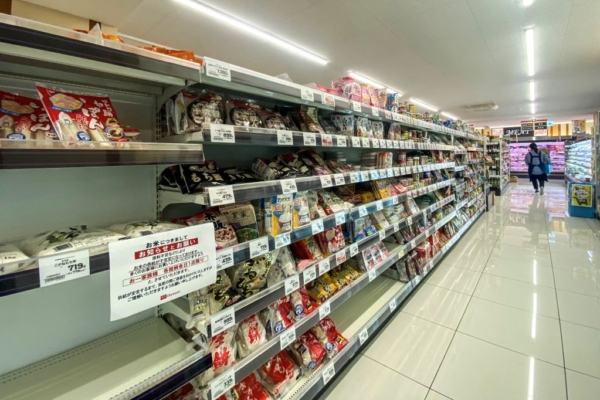Recently, there have been reports of rice shortages and purchase restrictions in various parts of Japan, with many supermarkets and stores having empty shelves. Some analysts attribute this to the combination of high summer temperatures and increased demand, but experts believe the fundamental reason lies in the reduced production policy aimed at maintaining prices.
In July, the price of rice in Japan rose by 18% compared to the same period last year, marking the largest increase in 20 years.
Starting from August, Ito-Yokado, a large chain supermarket under the Japanese retail giant Seven & i Holdings Co., tightened the purchase limits for rice nationwide, allowing each household to purchase only one bag.
Due to the record high temperatures this year, the proportion of premium rice in Japan’s main rice varieties has dropped to historic lows. In March of this year, the World Meteorological Organization (WMO) announced that last year was the hottest year on record and indicated that temperatures in 2024 may be even higher than those in 2023.
Last year, the famous rice-producing region of Niigata Prefecture suffered three episodes of “burning wind,” a phenomenon characterized by dry, hot winds, affecting both yield and quality significantly. As a result, the proportion of premium rice dropped to a historical low of 4.7%. In previous years, over 70% of the rice produced in the prefecture was premium grade in terms of appearance and quality.
In addition, earlier this month, Miyazaki Prefecture experienced a 7.1 magnitude earthquake, leading the Japan Meteorological Agency to issue warnings of an increased risk of a major earthquake in the Nankai Trough off the coast of the Pacific Ocean. This subsequently triggered panic buying of water and food products, impacting rice supplies as well.
Part of the rice shortage is also attributed to the increase in foreign visitors to Japan. It is estimated that the total number of foreign visitors to Japan in 2024 will reach a record 35 million.
However, Canon’s senior researcher Yamashita Kazuhito stated in his column that the fundamental reason for the rice shortage is the decrease in rice cultivation area leading to a decline in rice production. To maintain high prices, the agricultural, forestry, and fisheries departments continuously reduce rice supplies, which even with a slight increase in demand, can result in a rice shortage.
Yamashita pointed out that the “Heisei Rice Shortage” in Japan in 1993 was attributed to the cool summer, but the fundamental reason was still the decrease in rice cultivation area.
He mentioned that based on an estimated annual decrease of 1 million tons in rice demand, the Japan Agricultural Cooperatives (JA) and the Ministry of Agriculture, Forestry, and Fisheries (MAFF) have been reducing the rice cultivation area.
To prevent overproduction of rice and maintain rice prices, the Japanese government implemented the “reduction of cultivated land policy” in 1971. This policy limited rice cultivation area to around 60% of paddy fields. The remaining rice fields were either used to grow other crops or were left fallow. This ban was lifted in 2018.
According to the Nikkei Shimbun, although the reduction policy has been abolished, its effects have not yet been evident. Rice production for consumption has been declining continuously, with production at 7.56 million tons in 2021, a 20% decrease from 9.47 million tons in 2000.
Apart from the impact of population decline, institutions restricting rice production are still effective. Even after the cessation of the reduction policy, the Ministry of Agriculture, Forestry, and Fisheries continue to provide guidance for the country’s main rice production. The Japanese government also continues to provide subsidies to farmers who switch from rice farming to growing other crops.
On Wednesday, the Governor of Osaka Prefecture, Yoshimura Hirofumi, announced on the social media platform X that due to the overwhelming demand for rice, the expiration date for the rice subsidy coupons for households supporting child-rearing in Osaka Prefecture will be extended by a month until the end of November.
Two days ago, he revealed that nearly 80% of the supermarkets in Osaka had no rice to sell, prompting him to request the release of the national rice reserve from the Ministry of Agriculture, Forestry, and Fisheries.
He stated that the government has a stockpile of 1 million tons of rice and emphasized that “if supply is tight, there is no need to store rice in warehouses.” He also urged the public to consume rationally as new rice will be available in September.
Minister of Agriculture, Forestry, and Fisheries, Sakamoto Tetsushi, mentioned in a press conference on Tuesday that while there are calls to release the rice reserves, caution must be exercised as it may affect the supply and prices of rice based on private distribution.
The Ministry of Agriculture, Forestry, and Fisheries stated in a press conference on June 14th, “According to statistics from the Ministry of Finance and others, we do not see rice prices increasing significantly as reported in some news. The current supply and demand situation for staple rice is not tense based on trends in relative transaction prices and private sector distribution inventories. Consumers should be reassured.”
The Ministry urged consumers to remain calm and assured that new rice will be available in September, indicating that the shortage issue will soon be resolved.
A farmer in northern Aomori Prefecture told Kyodo News that despite the accelerated growth of rice due to high temperatures, the progress has been smooth without being impacted by typhoons, and there is no need for panic.

